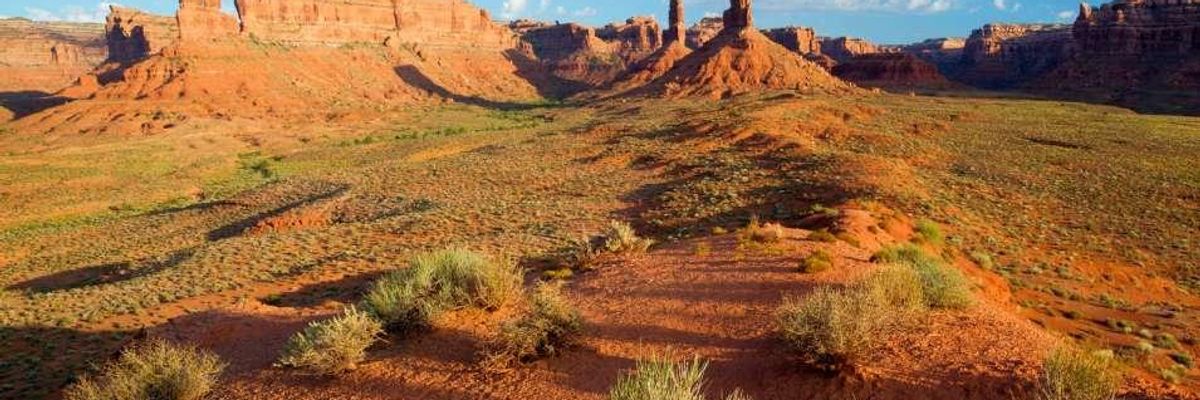
Indigenous groups fought for years for national monument designation for Utah's Bears Ears region--which is now in danger of being reduced in size following an Interior Department recommendation. (Photo: IIP Photo Archive/Flickr/cc)
In Latest 'Giveaway to Corporate Polluters,' Zinke Calls for Carving Up National Monuments
"Another in a long line of blatant handouts to the oil and gas industry," says green group
Environmental groups denounced the Interior Department's recommendation to President Donald Trump on Thursday that he reduce the size of some of the country's national monuments. While a number of outlets framed the story by reporting that Secretary Ryan Zinke was recommending against the elimination any monuments, a two-page summary (pdf) released by the Interior Department made clear his position that some of the country's protected lands are too large.
Trump ordered Zinke to review 27 monuments in April, declaring that President Barack Obama's use of the Antiquities Act of 1906 to establish new monuments amounted to an "egregious abuse of federal power."
The review angered groups including the Sierra Club and Utah Dine Bikeyah, a Native American coalition that had spent years campaigning for a national monument designation for Utah's Bears Ears region, a sacred tribal area. The latter group told the Associated Press Thursday that it was "prepared to launch a legal fight against even a slight reduction in size."
Ben Schrieber of Friends of the Earth called Zinke's recommendation to shrink some monuments "another in a long line of blatant handouts to the oil and gas industry" and a "giveaway to corporate polluters."
Greenpeace called the Interior Department's proposal "the direct result of Secretary Zinke favoring the voices of oil and gas executives instead of the people who submitted nearly 3 million public comments opposing changes to these important places." Last month, Zinke signed an order to expand oil and gas development on federal lands.
The exact phrasing of Secretary Ryan Zinke's review was not made public after it was submitted to the White House, but in the department's summary he wrote that the criteria for national monuments had become overly broad:
While early monument designations focused more on geological formations, archaeological ruins, and areas of historical interest, a more recent and broad interpretation of what constitutes an 'object of historic or scientific interest' has been extended to include landscape areas, biodiversity, and view sheds.
The summary promoted a return to using some parts of national monuments for so-called "traditional uses" by "industries such as grazing, timber production, mining, hunting and fishing, and motorized recreation."
Zinke also made the claim that while the use of national parks and monuments as tourist attractions, which contributed to $18.4 billion dollars last year to the national economy as 330 million people visited them, can be burdensome for the government. Tourism "places an additional burden and responsibility on the Federal Government to provide additional resources and manpower to maintain these lands to better support increased visitation and recreational activities," he said.
Jamie Henn of 350.org noted on Twitter the Trump administration's insistence in recent weeks on defending certain monuments, juxtaposed with its disregard for others.
\u201cAn administration that defends monuments to slavery but destroys protections for Indigenous lands and wilderness is morally bankrupt.\u201d— Jamie Henn (@Jamie Henn) 1503580611
An Urgent Message From Our Co-Founder
Dear Common Dreams reader, The U.S. is on a fast track to authoritarianism like nothing I've ever seen. Meanwhile, corporate news outlets are utterly capitulating to Trump, twisting their coverage to avoid drawing his ire while lining up to stuff cash in his pockets. That's why I believe that Common Dreams is doing the best and most consequential reporting that we've ever done. Our small but mighty team is a progressive reporting powerhouse, covering the news every day that the corporate media never will. Our mission has always been simple: To inform. To inspire. And to ignite change for the common good. Now here's the key piece that I want all our readers to understand: None of this would be possible without your financial support. That's not just some fundraising cliche. It's the absolute and literal truth. We don't accept corporate advertising and never will. We don't have a paywall because we don't think people should be blocked from critical news based on their ability to pay. Everything we do is funded by the donations of readers like you. Will you donate now to help power the nonprofit, independent reporting of Common Dreams? Thank you for being a vital member of our community. Together, we can keep independent journalism alive when it’s needed most. - Craig Brown, Co-founder |
Environmental groups denounced the Interior Department's recommendation to President Donald Trump on Thursday that he reduce the size of some of the country's national monuments. While a number of outlets framed the story by reporting that Secretary Ryan Zinke was recommending against the elimination any monuments, a two-page summary (pdf) released by the Interior Department made clear his position that some of the country's protected lands are too large.
Trump ordered Zinke to review 27 monuments in April, declaring that President Barack Obama's use of the Antiquities Act of 1906 to establish new monuments amounted to an "egregious abuse of federal power."
The review angered groups including the Sierra Club and Utah Dine Bikeyah, a Native American coalition that had spent years campaigning for a national monument designation for Utah's Bears Ears region, a sacred tribal area. The latter group told the Associated Press Thursday that it was "prepared to launch a legal fight against even a slight reduction in size."
Ben Schrieber of Friends of the Earth called Zinke's recommendation to shrink some monuments "another in a long line of blatant handouts to the oil and gas industry" and a "giveaway to corporate polluters."
Greenpeace called the Interior Department's proposal "the direct result of Secretary Zinke favoring the voices of oil and gas executives instead of the people who submitted nearly 3 million public comments opposing changes to these important places." Last month, Zinke signed an order to expand oil and gas development on federal lands.
The exact phrasing of Secretary Ryan Zinke's review was not made public after it was submitted to the White House, but in the department's summary he wrote that the criteria for national monuments had become overly broad:
While early monument designations focused more on geological formations, archaeological ruins, and areas of historical interest, a more recent and broad interpretation of what constitutes an 'object of historic or scientific interest' has been extended to include landscape areas, biodiversity, and view sheds.
The summary promoted a return to using some parts of national monuments for so-called "traditional uses" by "industries such as grazing, timber production, mining, hunting and fishing, and motorized recreation."
Zinke also made the claim that while the use of national parks and monuments as tourist attractions, which contributed to $18.4 billion dollars last year to the national economy as 330 million people visited them, can be burdensome for the government. Tourism "places an additional burden and responsibility on the Federal Government to provide additional resources and manpower to maintain these lands to better support increased visitation and recreational activities," he said.
Jamie Henn of 350.org noted on Twitter the Trump administration's insistence in recent weeks on defending certain monuments, juxtaposed with its disregard for others.
\u201cAn administration that defends monuments to slavery but destroys protections for Indigenous lands and wilderness is morally bankrupt.\u201d— Jamie Henn (@Jamie Henn) 1503580611
Environmental groups denounced the Interior Department's recommendation to President Donald Trump on Thursday that he reduce the size of some of the country's national monuments. While a number of outlets framed the story by reporting that Secretary Ryan Zinke was recommending against the elimination any monuments, a two-page summary (pdf) released by the Interior Department made clear his position that some of the country's protected lands are too large.
Trump ordered Zinke to review 27 monuments in April, declaring that President Barack Obama's use of the Antiquities Act of 1906 to establish new monuments amounted to an "egregious abuse of federal power."
The review angered groups including the Sierra Club and Utah Dine Bikeyah, a Native American coalition that had spent years campaigning for a national monument designation for Utah's Bears Ears region, a sacred tribal area. The latter group told the Associated Press Thursday that it was "prepared to launch a legal fight against even a slight reduction in size."
Ben Schrieber of Friends of the Earth called Zinke's recommendation to shrink some monuments "another in a long line of blatant handouts to the oil and gas industry" and a "giveaway to corporate polluters."
Greenpeace called the Interior Department's proposal "the direct result of Secretary Zinke favoring the voices of oil and gas executives instead of the people who submitted nearly 3 million public comments opposing changes to these important places." Last month, Zinke signed an order to expand oil and gas development on federal lands.
The exact phrasing of Secretary Ryan Zinke's review was not made public after it was submitted to the White House, but in the department's summary he wrote that the criteria for national monuments had become overly broad:
While early monument designations focused more on geological formations, archaeological ruins, and areas of historical interest, a more recent and broad interpretation of what constitutes an 'object of historic or scientific interest' has been extended to include landscape areas, biodiversity, and view sheds.
The summary promoted a return to using some parts of national monuments for so-called "traditional uses" by "industries such as grazing, timber production, mining, hunting and fishing, and motorized recreation."
Zinke also made the claim that while the use of national parks and monuments as tourist attractions, which contributed to $18.4 billion dollars last year to the national economy as 330 million people visited them, can be burdensome for the government. Tourism "places an additional burden and responsibility on the Federal Government to provide additional resources and manpower to maintain these lands to better support increased visitation and recreational activities," he said.
Jamie Henn of 350.org noted on Twitter the Trump administration's insistence in recent weeks on defending certain monuments, juxtaposed with its disregard for others.
\u201cAn administration that defends monuments to slavery but destroys protections for Indigenous lands and wilderness is morally bankrupt.\u201d— Jamie Henn (@Jamie Henn) 1503580611

